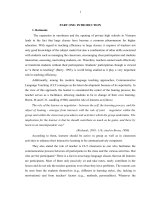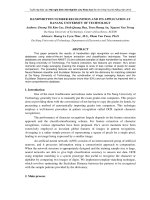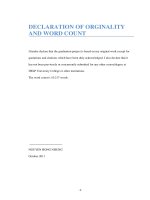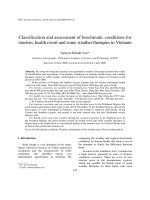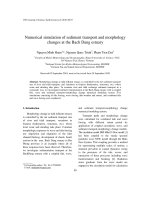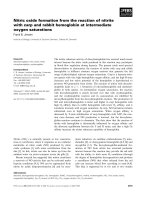Helping and voice behaviors at glaxosmithline vietnam
Bạn đang xem bản rút gọn của tài liệu. Xem và tải ngay bản đầy đủ của tài liệu tại đây (1.85 MB, 53 trang )
MASTER OF BUSINESS ADMINISTRATION
INTERNATIONAL PROGRAM
RESEARCH PROJECT
(BMBR5103)
HELPING AND VOICE BEHAVIOR AT
GLAXOSMITHLINE VIETNAM
STUDENT’S FULL NAME
: THAN THI VAN THI
STUDENT ID
: CGS00019384
INTAKE
: MARCH 2015
ADVISOR’S NAME & TITLE
: NGUYEN THE KHAI (DBA)
JULY 2016
ADVISOR’S ASSESSMENT
ADVISOR’S SIGNATURE
NGUYEN THE KHAI (DBA)
Page 1 /50
Business Research Methods
ACKNOWLEDMENTS
I would like to express my gratitude to lecturer NGUYEN THE KHAI (DBA) not only
for the immense knowledge but also for his never ending passion of teaching, sharing
and developing students. I would also greatly appreciate the way he plays strictly
teacher role in class which keep us always in fully concentrate and more
responsibility with our study time, push his students at high level of effort to complete
the thesis with quality.
Besides my advisor, I would like to thank the thesis tutor group: Ms Truc, Mr Hoanh,
Ms Hang who spent their value weekend time to train us the technique of data
analysis (SPSS), and sharing experience on common questions during conduct
research.
My sincere thanks to Ms To – Class monitor – who is always keep us be reminded
on timing, logistic arrangement, materials sharing.
Special thanks to my classmate, my close friend – Thai Nguyen – who shared the
details notes for my absent class, and patience to explain all the magic of
mathematics theories.
Student: Than Thi Van Thi
Business Research Methods
Page 2 /50
Finally, I must express my very profound gratitude to family for providing me with
unfailing support and continuous encouragement throughout my years of study and
through the process of researching and writing this thesis. This accomplishment
would not have been possible without them.
Thank you so much,
Than Thi Van Thi
Student: Than Thi Van Thi
Page 3 /50
Business Research Methods
TABLE OF CONTENTS
ABSTRACT
5
GSK’s INTRODUCTION
6
CHAPTER 1: OVERALL
14
1.1.
Research objectives
1.2.
Research scope
1.3.
Research questions
CHAPTER 2: LITERATURE REVIEW
2.1.
Relevancy Theories, related previous researches
15
2.3.
Hypotheses
19
2.4.
Research model
19
CHAPTER 3: RESEARCH METHOD
3.1.
Data collection
20
3.2.
Progress of data collection
21
3.3.
Data analysis processing flow
21
3.4.
Designing template
22
Student: Than Thi Van Thi
Business Research Methods
3.5.
Page 4 /50
Definition of constructs
3.5.1. Helping and Voice behavior
23
3.5.2. Organization Commitment (OC)
24
3.5.3. Supervisory Support (SS)
25
3.5.4. Empowerment at Work (EW)
26
3.5.5. Career Satisfaction (CS)
27
CHAPTER 4: RESULTS
4.1.
Descriptive statistics
28
4.2.
Reliability test - Cronbach’s Alpha
29
4.3.
Correlation analysis
31
4.4
Hypothesis testing
33
CHAPTER 5: CONCLUSIONS
5.1.
Study conclusions
35
5.2.
Study limitations
36
5.4.
Recommendations
37
REFERENCES & APPENDIX
References
38
Student: Than Thi Van Thi
Business Research Methods
Page 5 /50
Questionnaire
39
Presentation
45
Student: Than Thi Van Thi
Business Research Methods
Page 6 /50
ABSTRACT
5 consecutive years in top five of World Most Admired company by Fortune Magazine
with less than 4% employee turnover – GlaxoSmithKline (GSK) pharmaceutical
company shows its great and inspiring working environment where well appreciated with
corporation, team work and helping and voice behavior among associate.
This research is designed to find the factors influence to the Helping and Voice Behavior
at GSK Representative office Vietnam. It will use Business Research Methods – applied
the quantitative method with source data is from 510 employees of GSK representative
VN office and dedicated distributors associates to collect the ideas and comments of
employees about Helping and Voice behavior.
The survey’s result was collected and statistically analyzed from 270 qualified survey
completed by software SPSS version 20 (copyright of IBM). Hypotheses used this
research includes five constructs: one dependent construct is Helping and Voice behavior
and four independent constructs including: Organization Commitment, Supervisory
Support, Empowerment at Work at Career Satisfaction.
After examining all 4 hypotheses through correlation and regression analysis, the
research concluded that H1, H2, H3 are supported while H4 is not supported. In other
words, it means these 3 independent factors: Organization Commitment, Supervisory
Support, Empowerment at Work have positive effects on Helping and Voice Behavior at
GSK representative office (VN)
Student: Than Thi Van Thi
Business Research Methods
Page 7 /50
GSK’S INSTRODUCTION
Who we are?
GSK is a science-led global healthcare company that aims to deliver growth and
improving returns to shareholders through the development of innovative pharmaceutical,
vaccine and consumer healthcare products.
Our History:
GlaxoSmithKline started operations on 1 January 2001 following the merger of
GlaxoWellcome plc and SmithKline Beecham plc, but our combined histories go back
much further than that
Student: Than Thi Van Thi
Page 8 /50
Business Research Methods
1830
JOHN K SMITH OPENS HIS FIRST DRUGSTORE 1830 JOHN K SMITH OPENS
HIS FIRST DRUGSTORE IN P HILADELPHIA . JOHN' S YOUNGER BROTHER ,
GEORGE, JOINS HIM IN 1841 TO FORM JOHN K SMITH & CO.
1842
BEECHAM ’S P ILLS BRAND LAUNCHES (1942).
THOMAS BEECHAM LAUNCHES THE BEECHAM 'S P ILLS BUSINESS IN
ENGLAND. THE LAXATIVE IS TO BECOME WIDELY SUCCESSFUL
1906
‘GLAXO’ TRADEMARK IS REGISTERED
1963 – 1981
SUCCESSFULLY LAUNCHED NEW VACCINES , MEDICINES : BETNOVATE IN
1963(STEROID SKIN DISEASE TREATMENTS ), VENTOLIN IN 1969
(ASTHMA TREATMENT ); AMOXYCILLIN IN 1972 (ANTIBIOTIC);
AUGMENTIN -1981
2000
P LANNED MERGER OF GLAXO WELLCOME AND SMITHKLINE BEECHAM
IS ANNOUNCED ( TO G LAXOSMITHK LINE – GSK)
2009
STIEFEL ACQUIRED - VII V HEALTHCARE LAUNCHED
GSK BECOMES A LEADER IN SKINCARE WITH THE ACQUISITION OF
STIEFEL. GSK AND P FIZER LAUNCH VII V HEALTHCARE, A COMPANY
FOCUSED ON DELIVERING ADVANCES IN TREATMENT AND CARE FOR
HIV COMMUNITIES
2012
We are an official supplier to the Olympic and Paralympic Games, providing
laboratory services for official anti-doping measures
Student: Than Thi Van Thi
Business Research Methods
Page 9 /50
2015
In March 2015 we acquired Novartis’s vaccines business (excluding influenza
vaccines) and combined our Consumer Healthcare businesses to create a new
company
Where we are?
Presence in more than 150 countries all around the world with more than hundred
thousand (>100,000) employees working.
Mission
“At GSK, our mission is to improve the quality of human life by enabling people to do
more, feel better, live longer”
We are doing this by developing innovative products and improving access to healthcare
for patients around the world.
Key Achievement:
We have a network of 89 manufacturing sites, and large R&D centres in the UK,
US, Belgium and China.
We profiled around 40 new potential medicines and vaccines in our pipeline at our
R&D event in 2015, 80% of which we believe are potentially first-in-class
6 billion albendazole tablets donated to eliminate two neglected tropical diseases,
reaching over 760 million people.
More than 11,000 people work in R&D in our search for new medicines, vaccines
and consumer healthcare products.
We employ around 101,000 people in over 150 countries, with more than a third
of these in emerging markets.
In 2015, we distributed more than 690 million doses of vaccines around the world.
Our business model -How we create value
Our success depends on our ability to research and develop innovative healthcare
products and make them accessible to as many people as possible.
Student: Than Thi Van Thi
Business Research Methods
Page 10 /50
Organization structure and Corporate culture
In GSK – we aim to invest in our people and communities underpins the long term
sustainability of our business. Our employment practices are designed to create a culture
in which all GSK employees feel valued, respected, empowered and inspired to achieve
our goals.
GSK culture and core values
Our core values are patient focus, integrity, respect for people and transparency. We
expect our employees to share our values, to act transparently and with integrity at all
times.
We motivate our employees to put our values at the heart of every decision they make
through strong leadership, offering individual development opportunities and rewarding
employees for how they work as well as what they achieve.
We want everyone at GSK feel proud of the work that they do, the company they work
for, and the difference they make.
“Our values, and how we conduct ourselves, should be something that truly differentiates
us." Sir Andrew Witty - Chief Executive Officer
Student: Than Thi Van Thi
Page 11 /50
Business Research Methods
Patient focus
We focus on the individual, doing what is right for patients and customers.
Focusing on the patient's and consumer's needs in research
Ensuring patient/consumer safety is paramount
Ensuring product quality and reliability of supply
Integrity
We are committed to performance with integrity. Doing what is right for our patients and
consumers must be at the heart of every decision we make.
Respect for people
We support and inspire our colleagues to help them be the best they can be and to achieve
great things. Central to this is our day-to-day working culture, which is based on the
following foundations:
We ensure our workplace is safe and free of harassment and bullying
We actively seek, value and draw on the differing knowledge, perspectives,
experience and styles present in our global community of employees
We create an atmosphere of trust, in which concerns can be fully raised
Transparency
As our business evolves to meet global challenges, so does our culture – and transparency
is integral to this. For us, transparency means being honest about what we do, how we do
it and the challenges we face. We are open to challenge, to discussion and to improving
how we work to reflect our values.
PRODUCTS
After merging with Novartis Consumer Health in late of 2014 – GSK consumer health
products portfolio are enlarged by 4 key categories: Wellness, Oral Health, Skin Health
and Nutrition with some of the world’s best-loved healthcare brands including:
Sensodyne, Voltaren, Theraflu, Parodontax, Panadol, Polident and Otrivin.
Oral Health category
Student: Than Thi Van Thi
Business Research Methods
Page 12 /50
Skin health category
Nutrition category
Student: Than Thi Van Thi
Business Research Methods
Page 13 /50
Wellness category
GSK Representative Office Vietnam
Same as other countries, in Vietnam (or Indochina) representative office, GSK have 3
divisions which including: Pharmaceutical, Vaccine and Consumer Health.
Student: Than Thi Van Thi
Page 14 /50
Business Research Methods
In the scope of research, I did the survey for associates from GSK Consumer Health Care
(CH) division (supply Over the Counter /not request under doctor’s prescription product
only).
GSK Viet Nam Representative Office’s Organizational Structure
General
Manager
CFO
Support
functions
Marketing
Customer
Development
Logistic &
Demand
Planning
Finance
Regulatory
Expert MKT
Retail,
Pharmacy
Logistic
IT, HR (share
services)
Compliance
Trade MKT
Modern Trade
Demand
Planning
Legal
Consumer
MKT
Operation
Student: Than Thi Van Thi
Business Research Methods
Page 15 /50
CHAPTER 1: OVERALL
1.1. Why the research is conducted?
5 consecutive years in top five of World most admire company by Fortune Magazine
with less than 6% employee turnover – GlaxoSmithKline (GSK) pharmaceutical
company shows its great and inspiring working environment where well appreciated with
corporation, team work, helping and voice behavior among associates.
Although the great feedbacks from employees thanks for open, sharing behaviors at work
place and helping attitude – it’s somehow still spontaneous actions only.
Therefore, Management Board, especially leading team of Human resource would like to
study the factors which influence to Helping and Voice behavior in Representative VN
office and apply the implication of the study to replicate with purpose to create great
working place attract and maintain talents, improve quality of work, follow the GSK
vision “Do more – feel better – live longer”
1.2. Research Objectives
The research is aim to meet 3 major objectives below:
To deeply understand each factors definition and the original conceptual/personal
assumption of impact type/ influence to Helping and Voice behavior at GSK
Pharmaceutical Representative office.
Design research model and test related factors to check influence between factors
to access strong or weak level of each factor in influence to Helping and Voice
behavior.
Discussing and proposing recommendations to strengthen and replication Helping
and Voice behavior in maximize scale to improve the quality of working life and
productivity of work.
1.3. Research Scope
The scope of research is to include the complete survey with 510 employees (direct
contract or third party contract from DKSH - dedicated distributor) within Vietnam’s
territory. It was not included under probation maturity leave associates and top level of
management managers.
Contents of this research are only including factors influencing to Helping and Voice
behavior at GSK Vietnam Representative office and without any intention of re-structure,
or employment movement…
Student: Than Thi Van Thi
Page 16 /50
Business Research Methods
CHAPTER 2: LITERATURE REVIEW
This chapter is present the conceptually and literature review which were related to
Helping and Voice behavior, as well as some reference previous researches which
provided some conclusions/implications lead to my proposed hypothesis.
Reference Conclusions/ Implications from related previous Research:
No Research Name Author & other
Conclusions/Implications (*)
1
Helping and
1. Linn Van Dyne
1.Employees, peers, and supervisors
Voice Behavior
and
differentiate extra-role behavior from
2. Jeffrey A. LePine
in-role behavior
1
1
2. peer ratings of extra-role behavior
(helping and voice) increased
explained variance (3%) in
supervisor-rated performance six
months later.
3.Results suggested that discretionary
behavior is rewarded with high
performance ratings.
2
3
The Influence of
Psychological
Empowerment,
Intrinsic
Motivation, and
Creative Process
Engagement
1. Xiaomeng Zhang1
When Job
Dissatisfaction
Leads to
Creativity:
Encouraging the
Expression of
Voice
1. Jing Zhou1 and
and
2. Kathryn M. Bartol2
2. Jennifer M.
George2
Empowering leadership is likely to
have a stronger impact on
psychological empowerment to the
extent that an individual views
empowerment as part of his or her
employee role identity.
1.Feedback might have contributed to the
employees' belief that their creative actions
would be effective. because (1) the
feedback directed the employees' attention
toward learning and making improvements
on the job, (2) the feedback increased
employees' confidence that their creative
ideas had a good chance of being
supported by coworkers and subsequently
implemented
Student: Than Thi Van Thi
Page 17 /50
Business Research Methods
2. Dissatisfied employees with high
continuance commitment were more likely
to be creative when their coworkers were
helpful and supportive
3. Perceived organizational support for
creativity also can play a positive role in
channeling job dissatisfaction into
creativity
4
5
6
Supervisory
Power as an
Influence in
SupervisorSubordinate
Relations
1. James M. McFillen1
Marginal
Mentoring: The
Effects Of Type
Of Mentor,
Quality Of
Relationship,
And Program
Design On
Work And
Career Attitudes
Matching
Individual
Career Plans
and
Organizational
Career
Management
1. Belle Rose
In a comparison between subordinate
performance and supervisory power, a
supervisor's behavior is principally guided
by the nature of subordinate performance
Ragins1,
2. John L. Cotton2
and
3. Janice S. Miller3
1. Cherlyn Skromme
Granrose1 and
2. James D.
Portwood2
This observation supports the theory that
high-quality mentoring relationships have
a positive impact on protégés' job and
career attitudes (Kram, 1985).
Matching organizational career plans and
employee’s careers seem to have an
influence on satisfaction and desires to
leave or remain with an organization,
(*) Above conclusions, implications are partly extracted from full report with selected
parts to support for assumption to develop research hypothesis’s. Please review in full
study report to understand the full contents of study.
Maslow’s theory
How is this theory relevant to research?
Student: Than Thi Van Thi
Business Research Methods
Page 18 /50
As Maslow’s hierarchy of needs - is always forever theory which shown the nature of
human being for all aspects of psychology and physiology which impact to all related
study to human behaviors.
So, as a result, Maslow’s theory impacts to all dependent, independent variables in this
research with including: Helping and Voice Behavior, Organization Commitment,
Supervisory Support, Empowerment at Work, Career Satisfaction.
Contents
Maslow's hierarchy of needs is a theory in psychology proposed by Abraham Maslow
in his 1943 paper “A Theory of Human Motivation" in Psychological Review”.
Maslow subsequently extended the idea to include his observations of humans' innate
curiosity. His theories parallel many other theories of human developmental
psychology, some of which focus on describing the stages of growth in humans.
Maslow used the terms “physiological”, “safety”, “belongingness” and “love”,
“esteem”, “self-actualization” and “self-transcendence” to describe the pattern that
human motivations generally move through.
Maslow's theory was fully expressed in his 1954 book Motivation and Personality. The
hierarchy remains a very popular framework in sociology research, management
training and secondary and higher psychology instruction.
Herzberg’s two-factor theory
How is it relevant to this research?
In my opinion, Herzberg’s two-factor theory has shown that the factors that encourage
good if addressed will create satisfaction from that motivate employees to deliver better
Student: Than Thi Van Thi
Business Research Methods
Page 19 /50
results. This theory enables administrators to know the factors that cause dissatisfaction
for employees and thereby seeks to eliminate these factors.
For this scope of research – It likely shown the initial support for my assumption of
empowerment at work (type of motivation), and supervisory support can have the
positive impact to helping and voice behavior.
Contents
The two-factor theory (also known as Herzberg's motivation-hygiene theory and dual
factor theory) states that there are certain factors in the workplace that cause job
satisfaction, while a separate set of factors cause dissatisfaction. It was developed by
psychologist Frederick Herzberg, who theorized that job satisfaction and job
dissatisfaction act independently of each other.
Two-factor theory fundamentals: Attitudes and their connection with industrial mental
health is related to Abraham Maslow's theory of motivation. His findings have had a
considerable theoretical, as well as a practical, influence on attitudes toward
administration.
According to Herzberg, individuals are not content with the satisfaction of lower-order
needs at work; for example, those needs associated with minimum salary levels or safe
and pleasant working conditions. Rather, individuals look for the gratification of higherlevel psychological needs having to do withachievement, recognition, responsibility,
advancement, and the nature of the work itself.
Thus, satisfaction and dissatisfaction are not on a continuum with one increasing as the
other diminishes, but are independent phenomena. This theory suggests that to improve
job attitudes and productivity, administrators must recognize and attend to both sets of
characteristics and not assume that an increase in satisfaction leads to decrease in unpleasurable dissatisfaction
2.3. PROPOSED HYPOTHESE
As a result of above mentioned theoretical, I’m personally assume there is a positive
relationship of 4 constructions: Organization Commitment, Supervisory Support,
Empowerment at Work and Career Satisfaction into Helping and Voice Behavior at GSK
Vietnam Representative office. Therefore, I would propose four hypotheses (H) as below:
H1: There is a positive relationship between Organization Commitment and
Helping & Voice behavior.
H2: There is a positive relationship between Supervisory Support and Helping &
Voice Behavior.
H3: There is a positive relationship between Empowerment at Work and Helping
& Voice Behavior.
Student: Than Thi Van Thi
Business Research Methods
Page 20 /50
H4: There is a positive relationship between Career Satisfaction and Helping &
Voice Behavior.
Student: Than Thi Van Thi
Page 21 /50
Business Research Methods
2.1.
RESEARCH MODEL
+
+
+
+
Figure 1: Research model
Student: Than Thi Van Thi
Page 22 /50
Business Research Methods
CHAPTER 3: HYPOTHESIS & RESEARCH METHOD.
This part will present scale of questionnaire, description of constructs, method of research
project to analyses and evaluate result of survey for hypothesis.
3.1. Data collection progress
This study was conducted in GSK Representative office Vietnam base in HCM city for
direct contract with RO and nationwide dedicated employees from distributor DKSH
with 510 questionnaire sent out by directly hand delivery in HCM and post office for the
rest.
The participants for this survey were all associates level except top management such as:
General Manager, Board of Directors, and employees were under probation or maturity
leave period.
Key milestone timeline for research process:
Date
Working contents
15 May 2016 – 20 May 2016 Prepare, design survey, contact targeted respondents
21 May 2016 – 26 May
2016
Delivery to respondents with guideline how to inputs answer
27 May 2016 – 12 June
2016
13 June 2016 – 17 June
2016
Receive the completed questionnaire
Qualified completed
questionnaire for
analyze
Checking
Sent out: 510 questionnaires / Received back: 387
In valid and de-value: 112
Qualified: 275
Table 1: Timetable for data collection process
3.2. Data analysis
The result of these surveys shall be statistically analyzed by software SPSS version 22
(copyright of IBM) to find relationship and influence of four factors: Organization
Commitment, Supervisory support, Empowerment at Work, Career Satisfaction to
Helping and Voice Behavior of GlaxoSmithKline (GSK) Vietnam.
3.3. Measures – Design template scale:
Scales using for this research were based on the guideline from related
constructions of hypothesis. Since it was developed for more advance countries so
some of scales were adapted to meet the reality situation in Vietnam.
Student: Than Thi Van Thi
Page 23 /50
Business Research Methods
Therefore, in the scope of this thesis – I will use the 5-point Likert-type scales to
express/describe the opinions, judgment from respondents from 1,” strongly
disagree”, to 5,” strongly agree”.
Similarly, for number of items in each construction – some of items were taken
out from the survey analysis to rightly reflect the reality practical in local situation
3.4.
Data Analysis - Processing flow:
01
02
Descrriptive
analysis of
Factors
Reliability test
(Cronch's
Batch Alpha)
03
04
Correlation
Analysis
Linear
Regression
Figure 2: Process flow of data analysis
There are four steps for data analysis processing as below:
Descriptive analysis of all variable (both dependent and independent) including: one
hypothesized dependent variable - Helping and Voice behavior (HV), and 4 hypothesized
independent variable: Organization Commitment (OC), Supervisory Support (SS),
Empowerment at Work (EW), Career Satisfaction (CS)
1. Reliability test for all factors / variables.
2. Correlation analysis.
Student: Than Thi Van Thi



